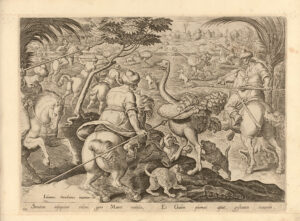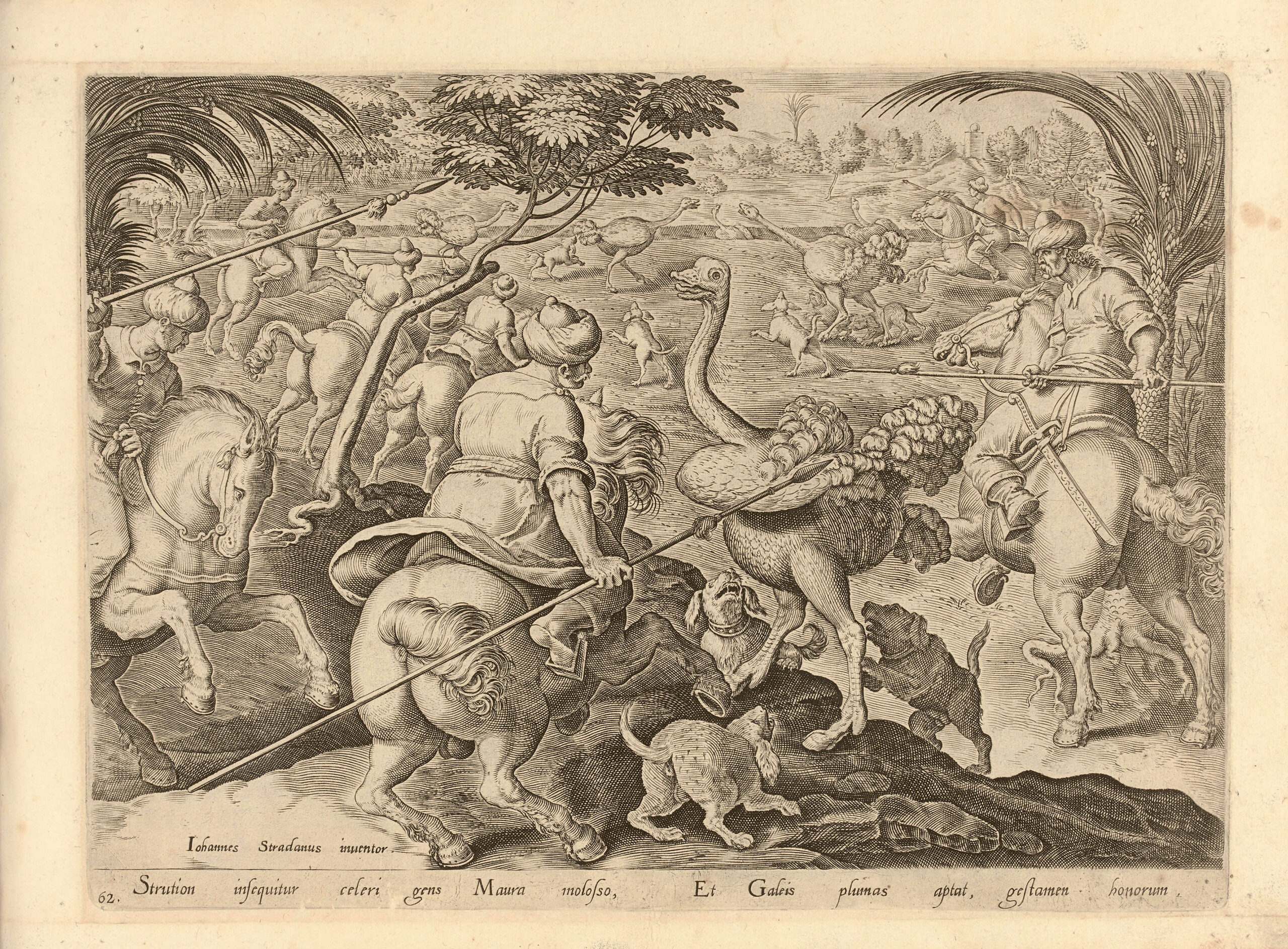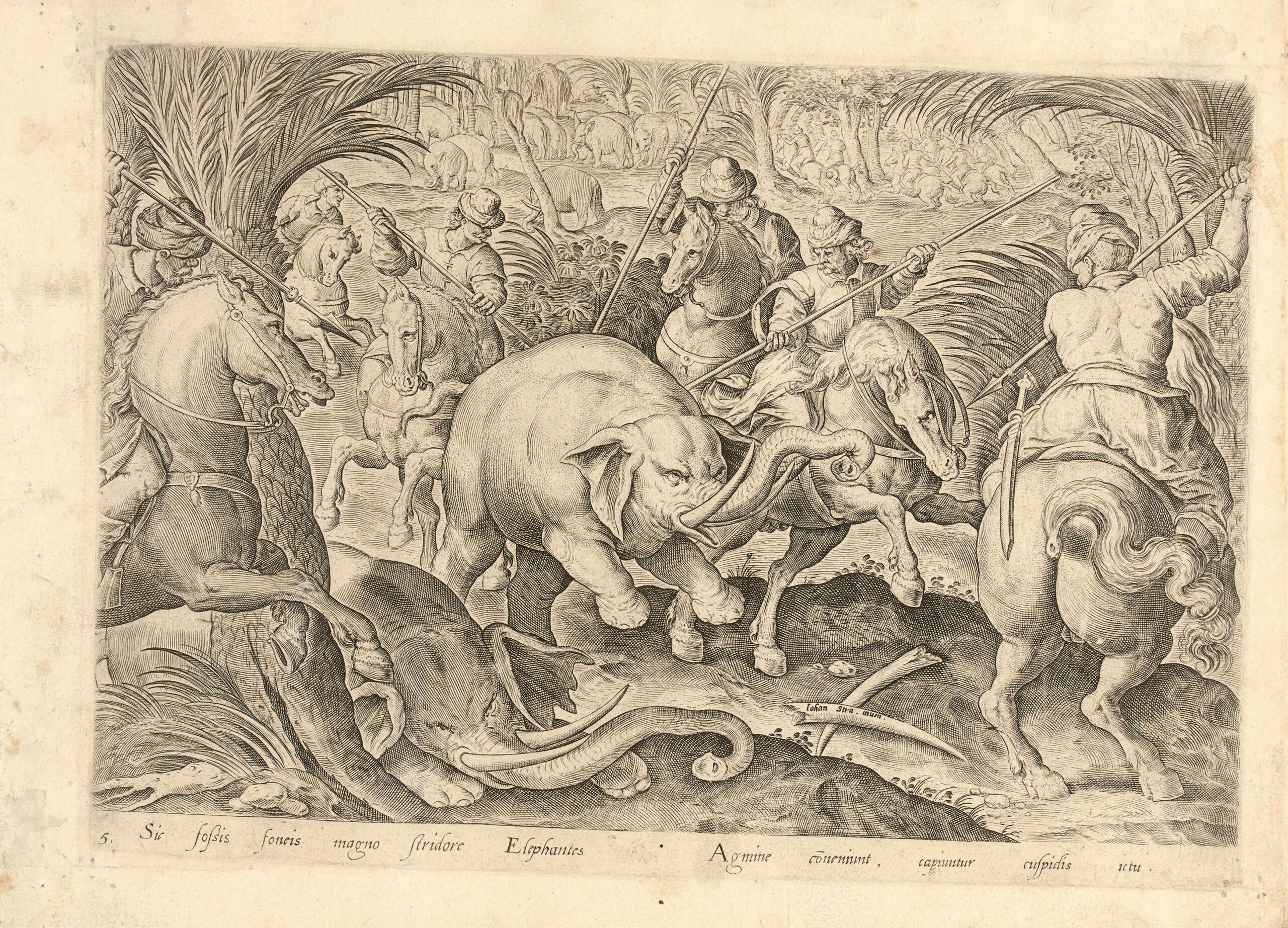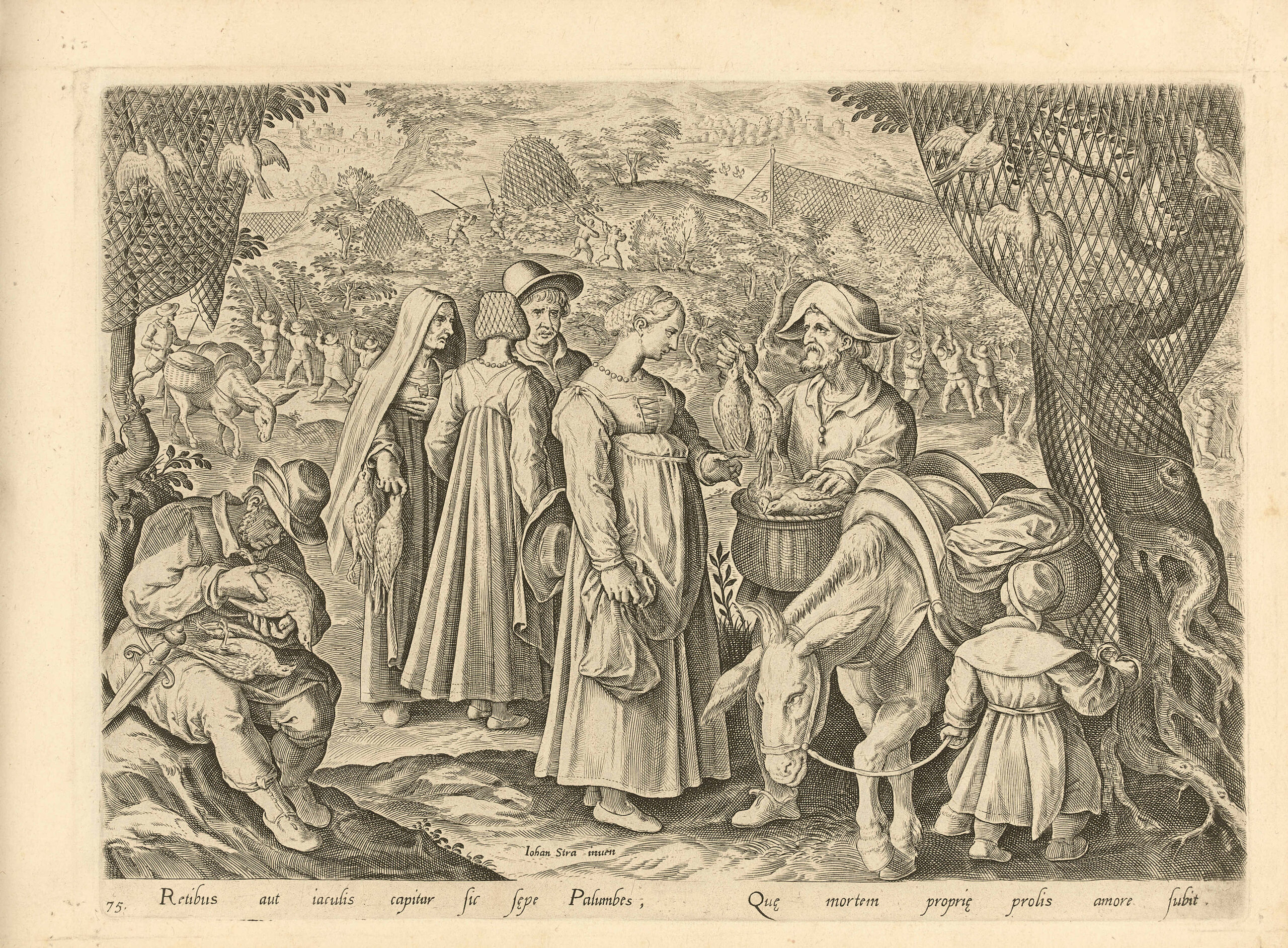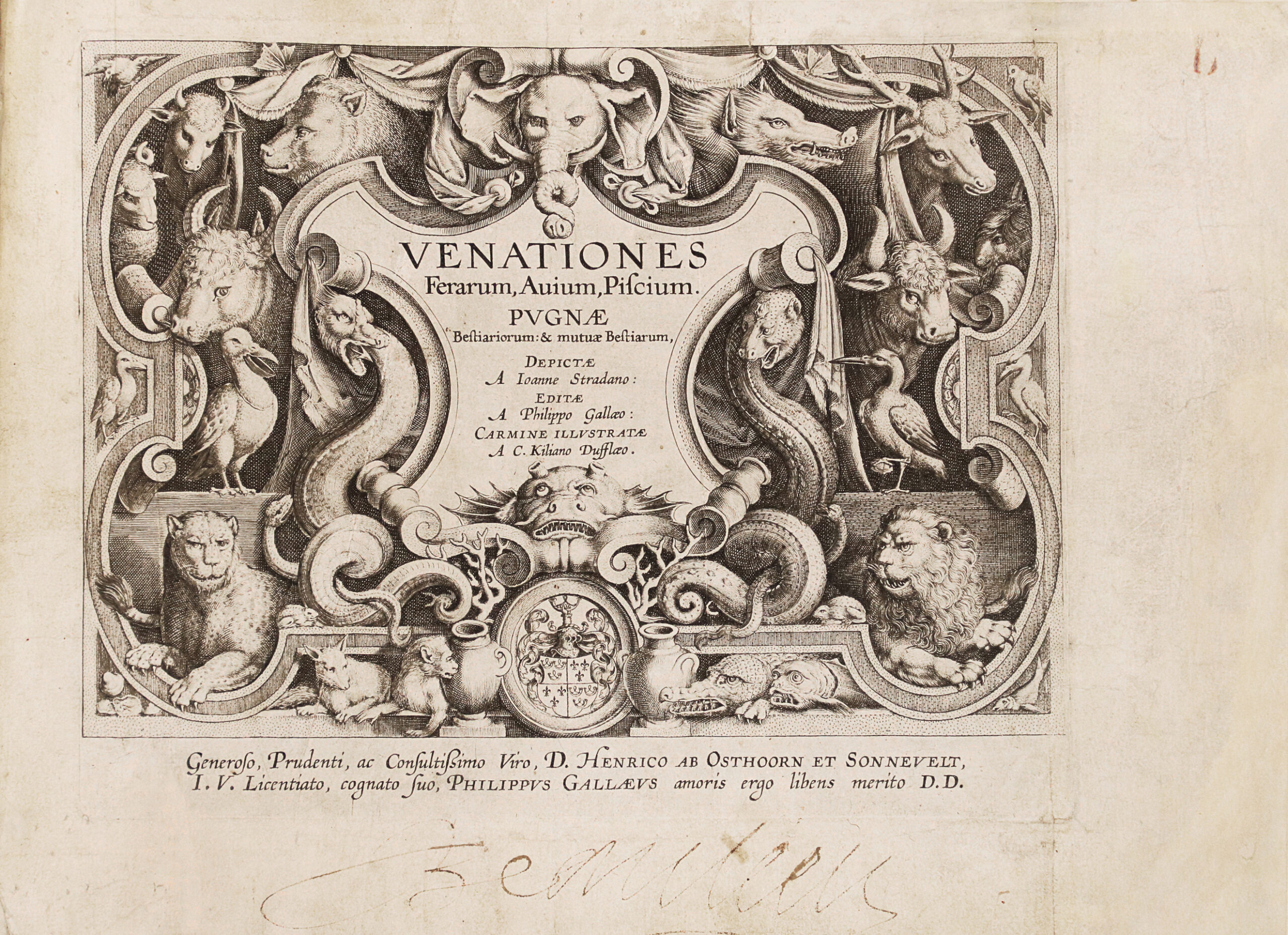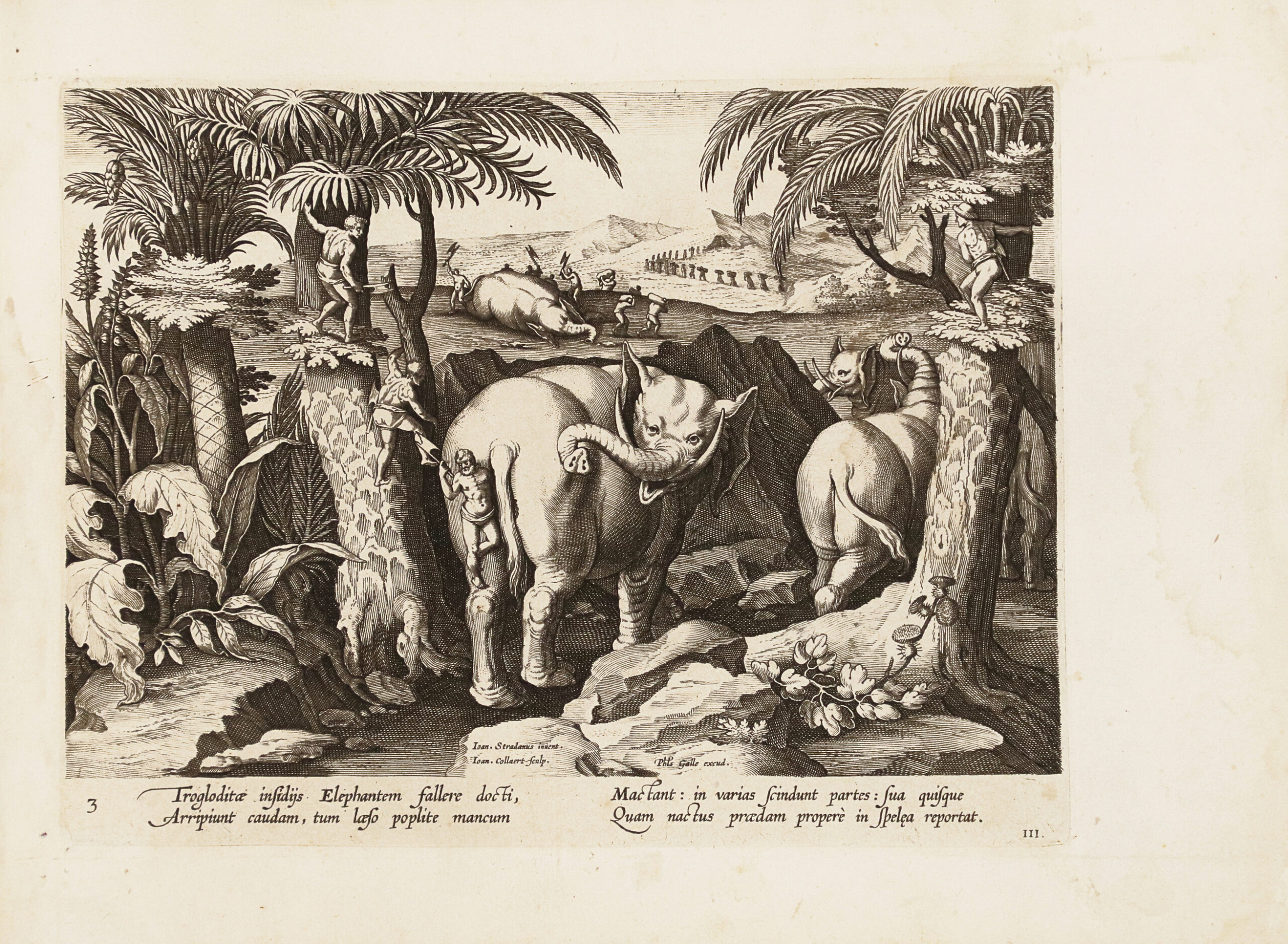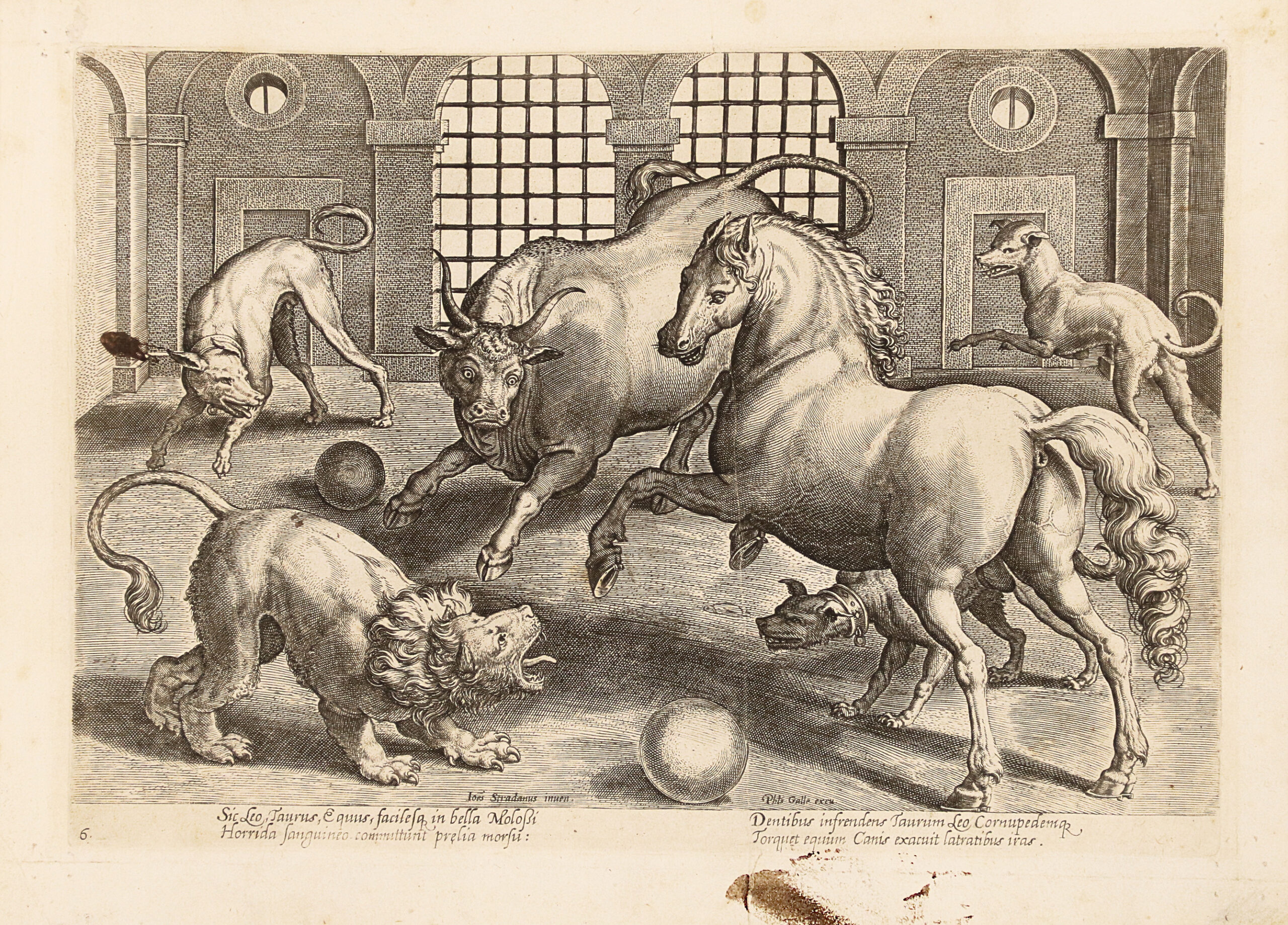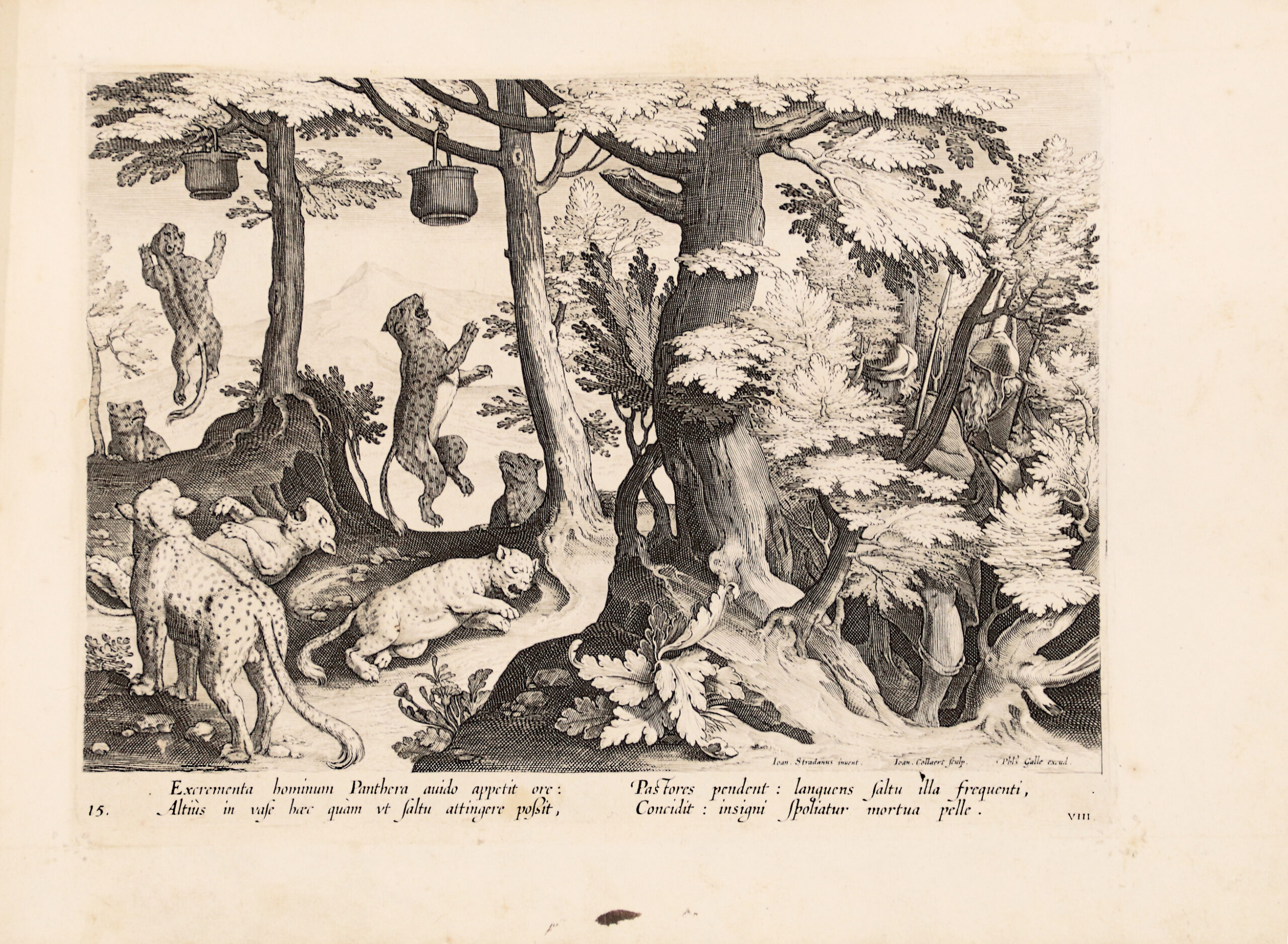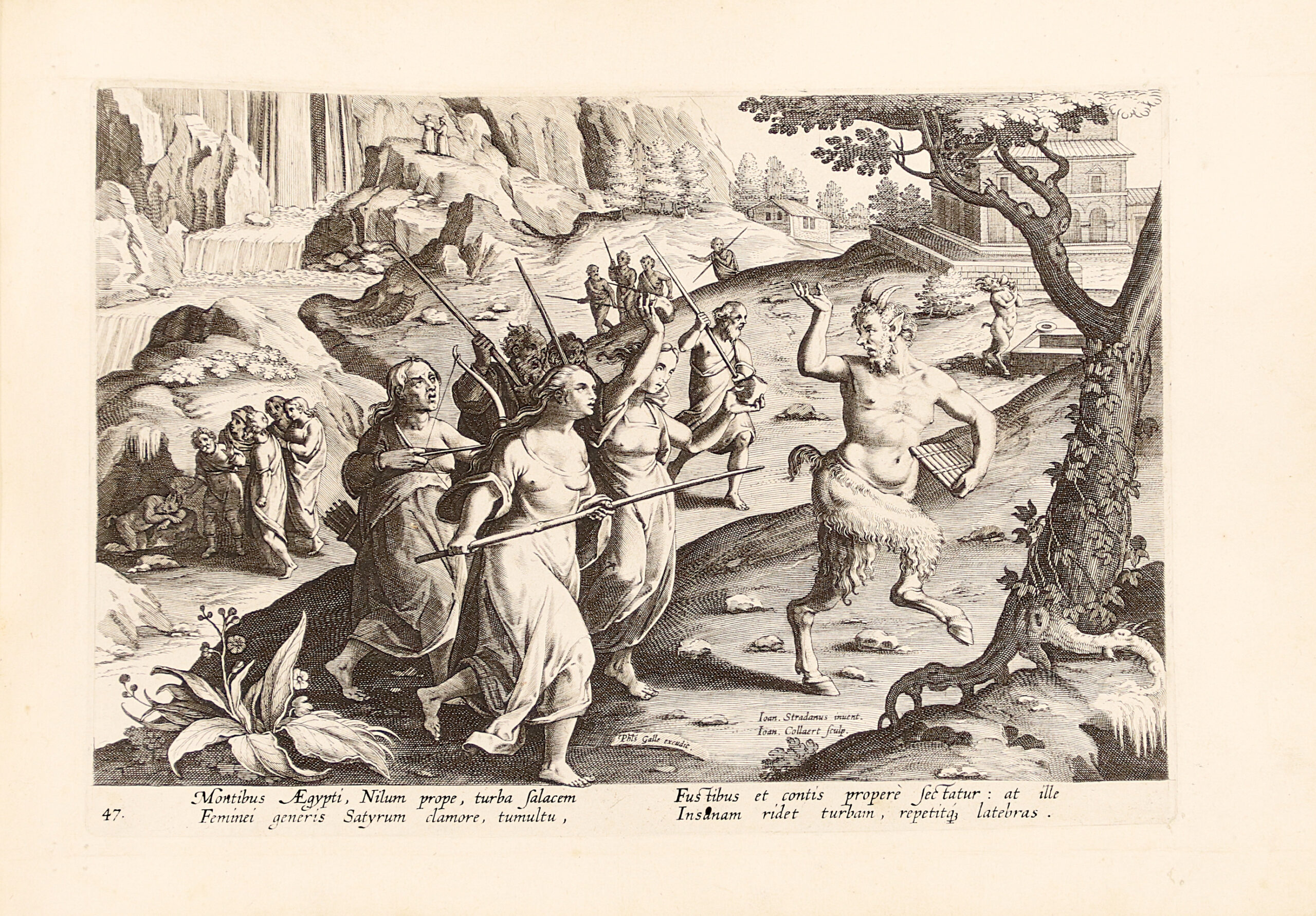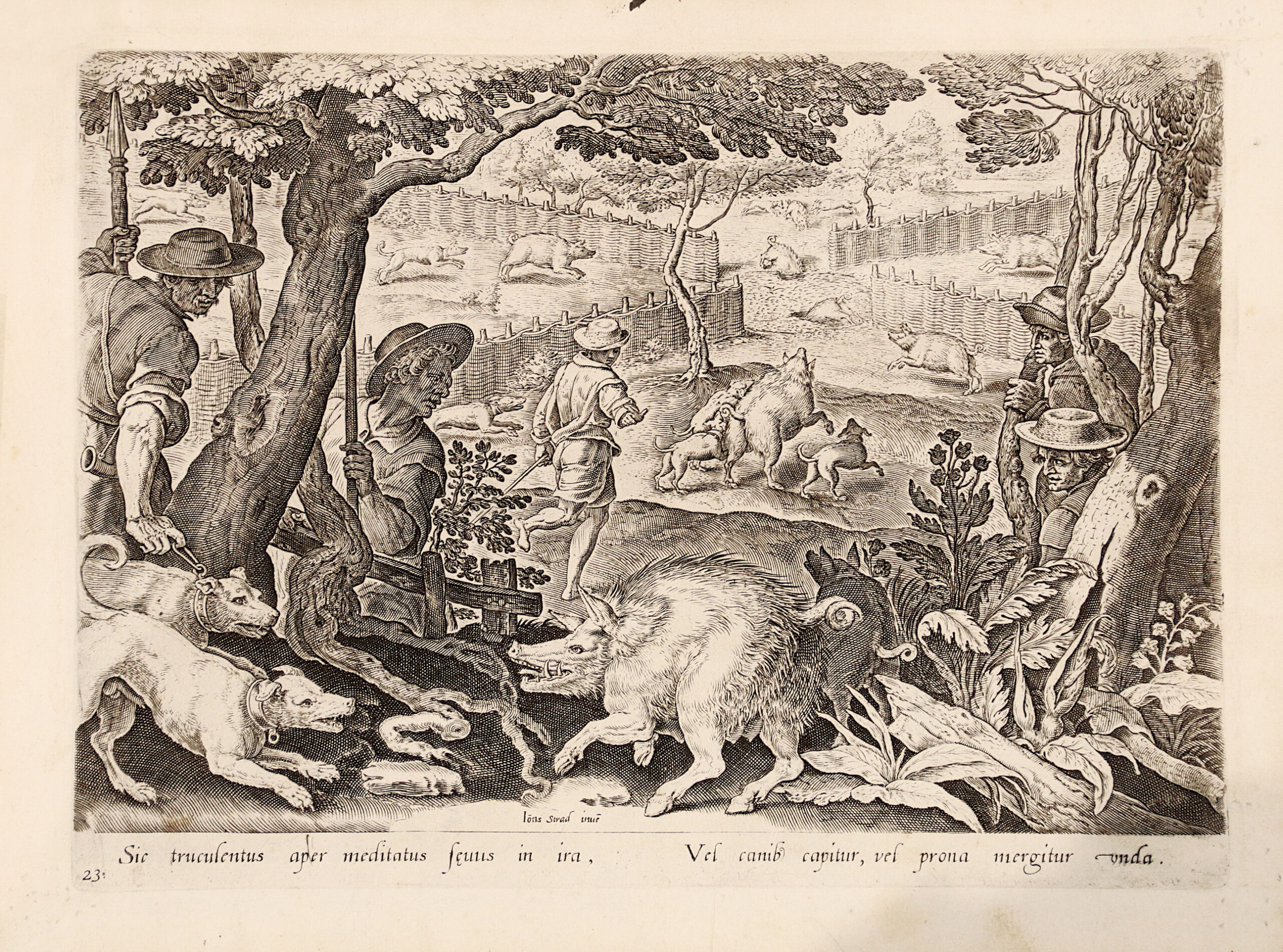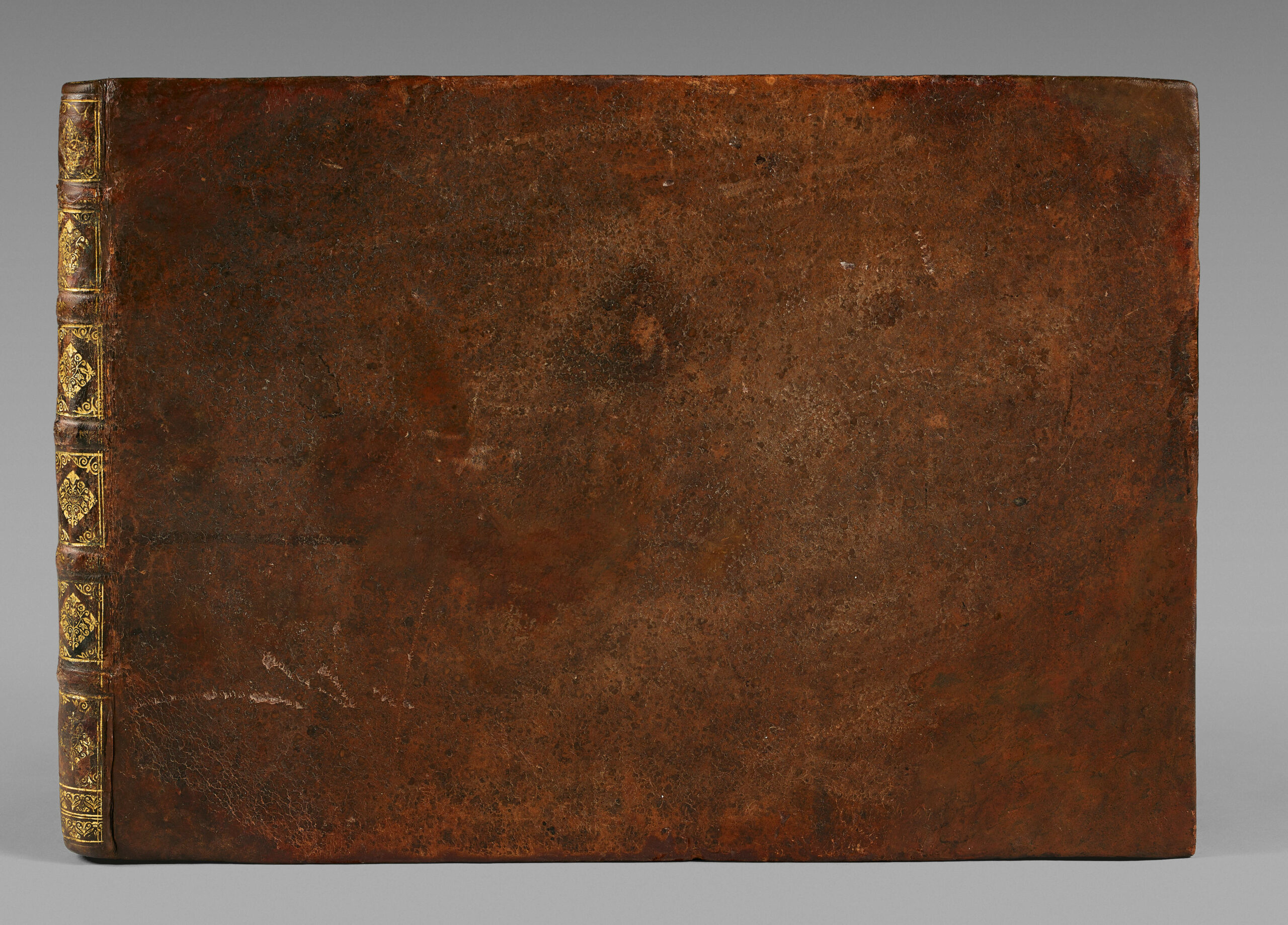Antwerp, J. Galle, [circa 1585].
Oblong folio [250 x 347 mm] of 1 l. of title and 104 plates numbered from 1 to 104. Engravings n° 4 and 17 are remargined, engraving n°103 is reinforced, a small portion of engraving 104 (of 5cm by 5cm) is missing and it is reinforced. Slight ink spot on the back of plates 3 and 6 not touching the engraving. Small brown stain in the margin of plates 9, 10, 11, 12, the plates 28, 50, 56 are misplaced, marginal restorations on the title. Brown calf, decorated spine ribbed. Binding from the beginning of the 17th century.
First issue of the edition printed in Antwerp circa 1585 before the printing on the title of the address “Antverpiae, apud Joannem Gallacum“, illustrated with a frontispiece and 104 plates mainly dedicated to hunting numbered from 1 to 104.
The hunts represented take place in various continents, with animals as exotic as panthers, leopards, elephants, but also more traditional types of hunts such as hunting with hounds, pigeons, deer…
The hunting scenes are also mythological, dragons, aquatic monsters are tracked on land and sea.
“They are signed Joan. Stradanus ivent., Joan. Collaert sculp., Joan. Galle excud. Some plates are engraved by Carol. De Mallery, Cornelius Galle, Theodorus Galle; quite a few do not bear the name of an engraver. All are accompanied by legends in Latin verse (four or two verses depending on the plates).” J. Thiébaud.
“Jan van der Straet, better known under the name of Stradanus, is the author of a set of drawings representing various hunting methods. The project of frontispiece, dedicated to Cosimo I de’ Medici, indicates that these drawings, based on his tapestry projects for the decoration of the Villa de Cosimo in Poggio a Caiano and executed at the Arazzia Medicae, were to be engraved at a later date.
The first edition dedicated to Cosimo I de’ Medici, a group of forty engravings executed by Philippe Galle in 1578, is not entitled, like the smallest previous editions. The first one, a series of four plates with decorative framings known as “Tapestry”, was engraved by Herman Jansz. Muller and published by Hieronymus Cock (HolI 512-15) in 1570. Several editions of Aux Quatre Vents followed, each with six plates, edited and perhaps also engraved by Adrien Collaert from 1574 to 1576.
The success of its untitled edition of 1578 undoubtedly prompted Philippe Galle to follow it up with a larger edition, 104 plates, intended for the Dutch market, with for the first time a title-page, but unfortunately undated.
The authors of these plates, several of which had already previously been used, are probably the brothers Cornelis and Theodor Galle, Adriaen and Hans Collaert, as well as Karel de Mallery. Each plate bears an inscription in popular Latin composed by Cornelis Kiliaan, proofreader at Plantin Editions. These are often inaccurate and it is obvious that they are not based on indications communicated by the artist. Philippe’s grandson, Joannes, eventually published other editions and the complete series was reengraved on new plates after 1612 for the Amsterdam editor, Claes Jansz. Visscher who had acquired the rights of the Galle family. An edition even dates from 1634…
The edition of the engravings spreading over a period of at least thirty years, the date of execution of these drawings is difficult to establish precisely. It would be possible to suggest that some drawings of this group, comparable in technique and style to a drawing by the same author dated 1556 preserved at the Fitzwilliam Museum in Cambridge, were executed before 1560 (see New York, European Drawings from the Fitzwilliam Museum , 1976-7, p. 58, no.91, rep .; engraved by Karel de Mallery and n ° 23 of the Venationes …). It is more likely, however, that most of these drawings were made after completion of the tapestries from Poggio a Caiano, which were woven around 1568.
Jan van der Straet (1523-1605), better known as Stradanus, worked most of his life in Italy as an engraver and designer for tapestry factories. From 1553 to 1571, at the service of Cosimo I de’ Medici, he set about creating hunting and fishing representations for tapestries to decorate the palace of Poggio a Caiano.
The Venationes commemorate the tapestries executed by Stradanus and showing the traditional hunting methods of the Renaissance.
“Jan van der Straet was born in Bruges, probably in 1523. He learned the basics of his profession in this city before going to Antwerp, in the studio of Pieter Aertsen where he stayed for three years. In 1545, he was registered at the guild of Saint Luc.
Towards the middle of the century, he left for Italy. From Lyons, where he stayed for a few months with the painter Corneille de La Haye, he went to Venice and then to Florence where he settled permanently in the 1550s and where his brilliant career was to take place.
From Giorgio Vasari, of whom he was one of the most important and faithful collaborators, and from Francesco Salviati, the one who was now called Giovanni Stradano, or Giovanni Della Strada, received the principles in the great Tuscan way, which he knew how to interpret in an original way. Under the direction of Vasari, he contributed to the vast transformation enterprise of the Palazzo Vecchio desired by the Duke Cosimo I de ‘Medici. He thus took part in the achievement of the great historical and mythological, narrative and allegorical cycles of the ducal apartments and the Salone dei Cinquencento, and soon became the first supplier of court tapestries. From 1567 to 1578, he produced the drawings of what was to be his most famous work: the Huntings hanging intended for the villa of Poggio a Caiano. In 1570, for the decor of the Studiolo of Prince Francesco I, the last of the great Vasarian companies, he painted an Alchemy Laboratory famous for its fiamminghismo, its Flemish “realism”. Stradano also participated in the renovation program of the great Florentine basilicas of Santa Maria Novella and Santa Croce. For Santo Spirito, he painted a Christ driving the merchants from the Temple which was much admired.
As early as 1563 he was elected, alongside Alessandro Allori, consul of the Accademia del disegno, recently established and destined to become the most illustrious of Florentine artistic institutions. He died in 1605 and was buried in Santissima Annunziata.
By the end of the 1560s, Stradano had started a long collaboration with the great print publishing houses in Antwerp. Hieronymus Cock, Cornelis Cort, Philip Galle, the Sadelers were among those who engraved and contributed to spread his inventions.
In 1578, Stradano and Galle planned to follow up on the engravings that Hieronymus Cock had published a few years before, based on the Hunting Tapestry from Poggio a Caiano.
Galle first published a series of prints without numbers, a second edition with frontispiece numbered from 2 to 44, finally a separate cycle of sixty-one new plates. The whole was gathered in a collection of one hundred and four plates accompanied by quatrains in Latin, for the most part composed by Cornelis Kiel. These were the “Venationes ferarum, avium, piscium, pugnae bestiariorum et mutuae bestiarum”: Hunts for wild beasts, birds, fishes, bestiary and beast fights with each other”. (Louvre Museum).
Copies of this famous 16th century book preserved in their contemporary binding are extremely sought-after, but they are rare.
